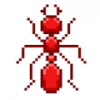Its been quite a while since the previous update and much has changed since then. As for the Lasius neoniger colony (in the test tube setup), one of the queens proved to be infertile and the other two mysteriously began to fed upon their brood pile until their was virtually nothing left aside from a few eggs, despite being kept in a dark environment free of vibrations and other small annoyances. The same happened to my Myrmica queen and her brood, one of my Crematogaster cf. cerasi colonies and my experimental Prenolepis imparis colony. Seeing that I had no other option, I released the remnants of these colonies into the wild. I had a feeling that this might occur and didn't let it affect my drive to keep moving forward with my other colonies. Raising colonies can be quite a gamble from time to time (as many of you are aware of). Although unfortunate, the death of one, if not multiple colonies, is to be expected (Especially throughout the course of the founding period). On another note, I have begun rearing termites and now have four colonies (each raised from either polygamous or monogamous pairings of primary reproductives). I have owned these colonies for approx. two months. The stats for these colonies are listed below :
Species : Reticulitermes flavipes
Colony 1: K : 1 Q : 1 N : 7-8 E : 5-6
Colony 2: K : 2 Q : 3 N : 13-14 E : 8
Colony 3: K : 2 Q : 3 N : 12-13 E : 11-12
Colony 4: K : 3 Q : 4 N : 7-8 E : 18-20
As for my remaining ant colonies, Their stats are listed here :
Crematogaster cf. cerasi : 7 larvae, 5 pupae, 7-9 eggs, 6 workers - This colony currently lives in a test tube setup secured to the bottom of a ventilated, plastic storage container with the use of fun-tack (a non-toxic putty). The walls of the container are red in color and the test tube itself is kept dark with the use of a cover constructed from a piece of paper.
Tetramorium sp.e - 1 queen - approx. 318 workers!!! - This colony has gone through a major growth spurt, becoming my largest Tetramorium sp.e coloy to date! They will be needing a new setup sometime next month or so. - Mini hearth (medium)
Tetramorium sp.e - 1 queen - approx. 196 workers - Although this colony has grown considerably in size since the last update, it still lags behind the others. The entire colony now lives primarily on the ceiling of their formicarium! - Mini hearth (medium)
Tetramorium sp.e - 1 queen - approx. 297 workers - After being rather stagnant for a brief period of time, this colony has produced batch upon batch of eggs and is now beginning to grow more rapidly. The entire ceiling and a portion of the floor of the formicarium are now completely covered with larvae of various sizes. A small chamber (approx. the size of a pistachio) is now completely filled with both eggs and pupae. - Mini hearth (Type 2 with top floor temporarily blocked with a rubber stopper)
Lasius neoniger - 1 queen - approx. 271 workers - the number of workers has grown considerably and the floor of the formicarium is almost entirely covered in larvae. the water tower is now almost completely covered by larvae of various sizes, pupae and rather large pile of eggs (The remaining queen has more than made up for the loss of her counterpart and is now laying eggs at a much faster rate.). - Mini hearth (large)
Tetramorium sp.e (Planned on being released back into the wild) - 1 queen (injured) - approx. 100 workers - RELEASED (Constructed a nest with several entrances under a shaded pine tree and is still going rather strong.) - "Atom A" formicarium in petri-dish outworld
These are the stats for the young colonies I have acquired since my last update :
Brachymyrmex depilis - 1 queen - approx. 25-28 eggs, 2-3 micro larvae - standard test tube setup with cover
Tetramorium sp.e colony - 8 queens - approx. 35 eggs, 50 larvae, 65 pupae - standard test tube setup with cover
Tetramorium sp.e colony - 1 queen - approx. 13 eggs, 5-6 larvae, 16 pupae - standard test tube setup with cover
Tetramorium sp.e colony - 1 queen - approx. 6 eggs, 6 larvae, 10 pupae - standard test tube setup with cover
Tetramorium sp.e colony - 8 queens - approx. 45 eggs, 65 larvae, 57 pupae - standard test tube setup with cover
Camponotus pennsylvanicus colony - 1 queen - approx. 15-17 eggs, 3-4 larvae, 5 pupae and 6 workers - Medium inception chamber
Edited by ctantkeeper, July 23 2017 - 8:48 PM.



















